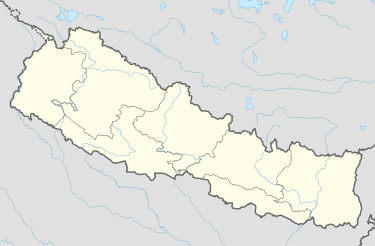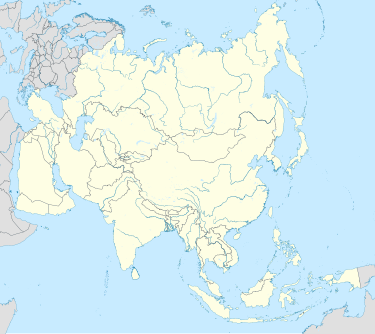Sunwal
Sunwal City
Sunawal, Golden Place, Golden Wall | |
|---|---|
| Sunwal Municipality | |
| Motto(s): | |
| Coordinates: 27°36′22″N 83°39′38″E / 27.60611°N 83.66056°Etype:city_region:NP|display=display=title, inline}} | |
| Country | |
| Province | Lumbini |
| District | Nawalparasi (West of Bardaghat Susta) district |
| Founded by | Golden King |
| No. of Wards | 13 |
| Government | |
| • Type | Mayor–council government |
| • Body | Sunwal City Municipality Government |
| • Mayor | Bimala Aryal (UML) |
| • Deputy mayor | Surya Prasad Dubey (UML) |
| Area | |
| • Municipal city | 173.50 km2 (66.99 sq mi) |
| Elevation | 131 m (430 ft) |
| Population | |
| • Municipal city | 72,621 |
| • Rank | 27th |
| • Density | 419/km2 (1,090/sq mi) |
| • Metro | 0.11 million |
| • Municipal rank | 29th |
| Time zone | UTC+05:45 (Nepal Standard Time) |
| Postal Code | 33000 |
| Area code | 078 |
| Website | www |
Sunwal City,[a] officially the Sunwal Municipal City,[b] is the urbanized and the most populous city of Parasi District with 72,621 native inhabitants living in 18,689 households in 2021[1] and 0.11 million people in its urban agglomeration. It is located in the Lumbini Province at an altitude of 131 metres (430 feet).
The city is one of the oldest continuously inhabited places in Lumbini, founded in the 15th century. The city was historically called the "Sunawal" and has been the home of the Brahmin, Chhetri, Gurung, Magar and Newar people, a cosmopolitan urban civilization in the Himalayan foothills. Today, it runs with the local government of the Nepalese republic, established in 2015, and is part of the Lumbini Province.
Demographics
[edit]At the 2011 Nepal census, Sunwal City had a population of 39,846 people living in 8,639 individual households. After the announcement of the municipality by combining two VDCs[clarification needed], the total population of Sunwal Municipality increased to more than 100,000, which is the highest for any municipality in Nawalparasi district. Swathi alone had a population of 10,629 with 2,102 individual households.[3][4]
There are informal settlements of squatters at Kerabari, Ramuwapur, Simaltari Charpala, Sirjanatole and Sundarbasti.[5]
Nearby tourist attractions
[edit]The Ramagrama stupa is a stupa located in Ramgram Municipality, about 11 km from Sunwal. This Buddhist pilgrimage site, which was constructed around 2500 BCE, contains relics of Gautama Buddha.[6] According to Buddhist texts, after Buddha's Mahaparinirvana, his cremated remains were divided and distributed among the princes of eight of the 16 mahājanapadās. Each of the princes constructed a stupa at or near his capital city, within which the respective portion of the ashes was enshrined.[7] One of them was Rāmagrāma, a major city of the Koliya kingdom (sometimes referred to as Koliyanagara) at that time.[8][9]
As of today, the Ramagrama stupa is the only intact and original stupa which contains relics of Buddha.[6] The 7-metre (23 ft) high stupa is now buried under a mound of earth and is awaiting further research.[7]
Notes
[edit]- ^ English: /ˌkætmænˈduː/,[2] Nepali: काठमाडौँ, pronounced [ˌkaʈʰmaɳˈɖu], Nepal Bhasa: 𑐫𑐾𑑃 𑐡𑐾𑐫𑑂/ येँ देय्
- ^ Nepali: काठमाडौँ महानगरपालिका, Nepal Bhasa: 𑐫𑐾𑑃 𑐩𑐴𑐵𑐣𑐐𑐬𑐥𑐵𑐮𑐶𑐎𑐵 / येँ महानगरपालिका
References
[edit]- ^ a b "praramvik natija janaganana (hindi) preliminary result census (tranl.) - Final Preliminary Report of Census 2021 (en)" (PDF). cbs.gov.np. Archived from the original (PDF) on 6 February 2022. Retrieved 22 February 2022.
- ^ "Definition of Kathmandu in English". Oxford Dictionaries. Archived from the original on 15 November 2014. Retrieved 13 June 2022.
- ^ "Nepal Census 2011". Nepal's Village Development Committees. Digital Himalaya. Retrieved 18 December 2008.
- ^ Central Bureau of Statistics of Nepal: National Population and Housing Census Archived 2013-07-31 at the Wayback Machine
- ^ Paudel, Devi Prasad (2017). "Livelihood Strategy and Vulnerability of Squatters' Settlement: A Case of Sunwal Municipality, Nawalparasi, Western Nepal". SJPG. 40 (1).
- ^ a b UNESCO (2014). "Ramagrama, the relic stupa of Lord Buddha". Tentative Lists. Paris: UNESCO World Heritage Centre. Retrieved 30 November 2014.
- ^ a b Shrestha, SS (1999). "Ramagrama excavation" (PDF). Ancient Nepal: Journal of the Department of Archaeology. 142: 1–12. Retrieved 30 November 2014.
- ^ "Rāmagāma". Palikanon.com. Retrieved 16 May 2015.
- ^ "Koliyā". Palikanon.com. Retrieved 16 May 2015.



